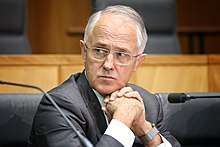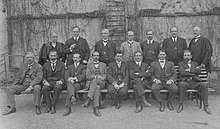Council of Australian Governments
The Council of Australian Governments (COAG) was the primary intergovernmental forum in Australia from 1992 to 2020.[3] Comprising the federal government, the governments of the six states and two mainland territories and the Australian Local Government Association, it managed governmental relations within Australia's federal system within the scope of matters of national importance.
Council of Australian Governments | |
| Successor | National Cabinet[1] |
|---|---|
| Formation | 1992 |
| Dissolved | 29 May 2020[1] |
| Type | Governmental organisation |
| Purpose | Management of matters of national importance to Australia[2] |
Region | Australia |
Membership |
|

On Friday 29 May 2020, Prime Minister Scott Morrison announced that COAG would be replaced by a new structure based on the National Cabinet implemented during the COVID-19 pandemic.[1]
History

COAG grew out of the Premiers' Conferences, which had been held for many decades. These were limited to the premiers of the six states and the Prime Minister. A related organisation is the Loan Council, which coordinates borrowing by the federal and state and territorial governments of Australia.
COAG was established in May 1992 after agreement by the then Prime Minister (Paul Keating), premiers and chief ministers, and it first met in December 1992. It is chaired by the Prime Minister. It meets to debate and co-ordinate government activities between the federal and state or territorial governments and between the state and territorial governments themselves as well as issues affecting local government.
COAG differs from the US's National Governors Association or Canada's Council of the Federation, because these bodies only include state/provincial representatives, whereas COAG also includes federal and local representatives.
At a 13 March 2020 COAG meeting, it was announced that a new National Cabinet was being formed of the Prime Minister and the premiers and chief ministers of the states and territories to coordinate the response to the COVID-19 pandemic in Australia.[4]
On 29 May 2020, Prime Minister Scott Morrison announced that COAG would be replaced by a new structure based on the National Cabinet.[1]
Final membership
| Name | Office held | In office since | Party | |
|---|---|---|---|---|
| Scott Morrison MP | Prime Minister of Australia | 24 August 2018 | Liberal | |
| Gladys Berejiklian MP | Premier of New South Wales | 23 January 2017 | Liberal | |
| Daniel Andrews MP | Premier of Victoria | 4 December 2014 | Labor | |
| Annastacia Palaszczuk MP | Premier of Queensland | 14 February 2015 | Labor | |
| Mark McGowan MLA | Premier of Western Australia | 17 March 2017 | Labor | |
| Steven Marshall MP | Premier of South Australia | 19 March 2018 | Liberal | |
| Peter Gutwein MHA | Premier of Tasmania | 20 January 2020 | Liberal | |
| Andrew Barr MLA | Chief Minister of the Australian Capital Territory | 11 December 2014 | Labor | |
| Michael Gunner MLA | Chief Minister of the Northern Territory | 31 August 2016 | Labor | |
| Mayor David O'Loughlin | President of the Australian Local Government Association[5] | November 2016 | Labor | |
COAG and state finances
Australia is believed to be the first federation to have introduced a formal system of horizontal fiscal equalisation (HFE) which was introduced in 1933 to compensate States which have a lower capacity to raise revenue. Many federations use fiscal equalisation to reduce the inequalities in the fiscal capacities of sub-national governments arising from the differences in their geography, demography, natural endowments and economies. However the level of equalisation sought varies. In Australia, the objective is full equalisation.
Full equalisation means that, after HFE, each of the six states, the Australian Capital Territory and the Northern Territory would have the capacity to provide services and the associated infrastructure at the same standard, if each state or territory made the same effort to raise revenue from its own sources and operated at the same level of efficiency.
Currently the funds distributed to achieve HFE are the revenues raised from the Goods and Services Tax (GST), currently about AUD50bn a year. The distribution of GST required to achieve HFE is decided by the Federal Treasurer each year, on the basis of advice provided by the Commonwealth Grants Commission (CGC).
Achieving HFE does not mean that the states and territories are directed how to raise revenue or how to spend their funds. GST revenue grants from the Commonwealth are unencumbered and available for any purpose. Accordingly, HFE equalises fiscal capacity, not fiscal policies which remain for the states and territories to decide for themselves. It does not result in the same level of services or taxes in all states and territories, direct that the states and territories must achieve any specified level of service in any area, nor impose actual budget outcomes in accordance with the Commission's calculations.[6]
At its meeting on 13 December 2013, COAG agreed to streamline the COAG council system and refocus on COAG's priorities over the next 12 to 18 months.
List of COAG councils
There are now twelve COAG councils:
- Federal Financial Relations Council
- Disability Reform Council
- Transport and Infrastructure Council
- Energy Council
- Skills Council
- Council of Attorneys-General
- Education Council
- Health Council
- Joint Council on Closing the Gap
- Indigenous Affairs Council
- Australian Data and Digital Council
- Women’s Safety Council
There is no longer a distinction between standing and select councils, as all councils are time-limited.[7]
Criticism
In 2012 a group of 20 environmental organisations released a joint communiqué denouncing the establishment of the COAG Business Advisory Forum and wanted wider representation on the Forum. The groups also opposed the weakening of environmental regulations.[8]
After the forum's abolition in early 2020, journalist Annabel Crabb wrote that, after initial utility in the 1990s, COAG had become a "sclerotic nightmare" producing "communiques of impenetrable bureaucratese". She suggested that the meetings in Canberra had produced a performative element in which state premiers sought to boost their profile at the expense of actual reforms.[9]
See also
- National Cabinet of Australia
- Joint Ministerial Committee (UK), Similar body in the United Kingdom
- First Ministers' conference, Similar body in Canada
- National Governors Association, Similar body in the United States of America
- Federal Council of Australasia, pre-1901 equivalent
- Fiscal imbalance in Australia
- Inter-State Commission
- MCEETYA, Ministerial Council on Education, Employment, Training and Youth Affairs
- COAG Reform Council
References
- Scott Morrison says National Cabinet here to stay, will replace COAG meetings in wake of coronavirus ABC News 29 May 2020
- Council of Australian Governments. "About the Council of Australian Governments". Council of Australian Governments. Retrieved 5 May 2020.
- "About COAG". Council of Australian Governments. Retrieved 6 May 2020.
- "Advice on coronavirus". Prime Minister of Australia (Press release). 13 March 2020. Retrieved 1 April 2020.
- Australian Local Government Association (2010). "President: Australian Local Government Association". Retrieved 31 March 2016.
- Commonwealth Grants Commission
- "Archived copy". Archived from the original on 20 May 2015. Retrieved 16 June 2015.CS1 maint: archived copy as title (link)
- "Australian Groups Protest Business 'Attack' on Environmental Laws". Canberra, Australia: Environment News Service. 5 June 2012. Archived from the original on 9 June 2012. Retrieved 11 June 2012.
- Crabb, Annabel (7 June 2020). "In hoping to reform the Federation, Morrison has sailed into treacherous waters". ABC News. Retrieved 7 June 2020.